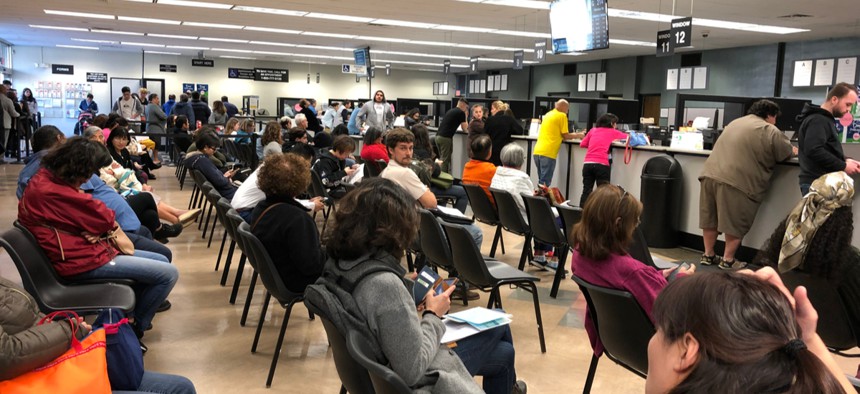Why Federal Agencies Can’t Ignore the AI Buzz Much Longer

Customers wait at a California Department of Motor Vehicles. By Michael Gordon/Shutterstock.com
It won't be a buzzword forever.
Anyone standing in line at the Department of Motor Vehicles has probably wondered why the waits are so long. Why it’s seemingly so difficult to complete basic tasks. Why, in this digital age, we can’t apply a little modern technology to take the pain out of such agonizing experiences.
We’ve also heard the buzz about artificial intelligence potentially coming along to save the day by automating overly bureaucratic processes to make our lives simpler. And many government officials probably think that’s all it is—buzz—right?
Well, not for long. While AI doesn’t appear ready to debut at the driver registration counter anytime soon, it is beginning to find its way into other government operations. Indeed, worldwide spending on AI systems is expected to hit nearly $98 billion by 2023, driven in large part by public sector adoption, according to IDC.
That’s because nobody is more aware than government organizations themselves of the annoyances that go along with antiquated procedures. While the private sector races ahead with modern productivity and life-enhancing technologies, non-defense agencies often struggle to do the same. Many people cling to older computers, operating systems and communications gear because they seem to work well enough and don’t bust their often-meager budgets. As a result, though, these departments take longer to complete projects and are less able to deliver service levels that citizens desire and deserve.
Automated into Action
As a result, AI is becoming more interesting for many government agencies. They are open to exploring the potential benefits of AI in the workplace, from automating time-consuming manual tasks to advanced data mining. In practical use, AI is more about augmenting human capabilities to make us more productive, a fact that is probably fueling a White House plan to spend nearly $1 billion on non-defense AI research and development in 2020.
The productivity advantages of AI for the public sector cannot be underestimated. According to Deloitte research, up to 1.2 billion of the estimated 4.3 billion hours that government employees work each year could be freed up today using AI. What’s more, Deloitte estimates agencies could save as much as $41.1 billion annually by using this technology to automate various processes.
No doubt, deploying AI will displace some percentage of employees performing relatively low-skilled and “repeatable” tasks. However painful for those individuals, industry observers note people always worry about job loss when technological progress comes along to improve operational efficiency and productivity. In addition, analysts such as Gartner have predicted that AI will create more jobs than it eliminates by leading to as yet unknown innovations that will require new employees with special skills.
Improving Citizen Services
Beyond the productivity benefits, AI could also enable government agencies to deliver a level of service few citizens have thought about or expect today. For instance, imagine a city’s water main breaking. Today, a nearby resident might contact the local water utility to alert them to the issue. Between the time of the citizen call, the repair truck hitting the road and the problem being resolved, all sorts of local problems could occur. Snarled traffic. Inadequate water flow for firefighters in an emergency. Homeowners left wondering if they forgot to pay their water bill when the dishwasher or shower stopped working.
But with AI, sensors would immediately alert the utility to the main break before the citizen even notices. The system might calculate the best route for repair crews to take to reach the problem spot. It could also reroute water to local fire hydrants for the duration of the event. It could even utilize various APIs to let residents know they’ll be without water for a short time and provide digital updates on the repairs.
This small smart city example might seem a bit far-fetched. But AI is already being used by some governments around the world to do everything from helping public servants make welfare payments and immigration decisions to planning new infrastructure projects, answering citizen inquiries through chatbots, setting bail hearings and establishing drone flight paths.
Overcoming Security Hurdles
AI is also becoming a topic of conversation among legislators who see it as a possible solution for the massive backlog of government security clearances. In February government officials rolled out plans for their Trusted Workforce 2.0 framework, which strives to use technology to make background investigations a daily, rather than every five to 10-year, event.
In addition, AI is gaining attention for its ability to both defend against and create cybersecurity issues. Security professionals and legislators alike are growing worried about the potential to weaponize AI to create new generations of malware that automatically target larger groups of vulnerable individuals or agencies in ways that are even more difficult to detect or defend against. Of even more concern, because AI is based on machine learning, malware could theoretically adapt in real time to any cyber-defenses, giving hackers a constant leg up in their attacks.
There are few good examples of this occurring yet. But that’s not stopping some vendors from trying to fight AI fire with AI fire. For instance, one recently announced anti-malware solution utilizes deep learning AI technology to look for behavioral patterns that could indicate a pending cyberattack. It’s one of the first instances of trying to predict and shut down a looming threat as opposed to merely noting abnormal behavior already under way and then isolating it.
Artificial intelligence will almost certainly offer the public sector far more benefits than challenges as it continues to evolve and ready itself for primetime. To keep up with the speed at which AI applications are evolving, government agencies should start to adapt their programs now and evaluate how AI can best assist in the future.
Todd Gustafson is president of HP Federal.





